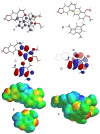Attenuation of cytotoxic natural product DNA intercalating agents by caffeine
- PMID: 22145102
- PMCID: PMC3221498
- DOI: 10.3797/scipharm.1107-19
Attenuation of cytotoxic natural product DNA intercalating agents by caffeine
Abstract
Many anti-tumor drugs function by intercalating into DNA. The xanthine alkaloid caffeine can also intercalate into DNA as well as form π-π molecular complexes with other planar alkaloids and anti-tumor drugs. The presence of caffeine could interfere with the intercalating anti-tumor drug by forming π-π molecular complexes with the drug, thereby blocking the planar aromatic drugs from intercalating into the DNA and ultimately lowering the toxicity of the drug to the cancer cells. The cytotoxic activities of several known DNA intercalators (berberine, camptothecin, chelerythrine, doxorubicin, ellipticine, and sanguinarine) on MCF-7 breast cancer cells, both with and without caffeine present (200 μg/mL) were determined. Significant attenuation of the cytotoxicities by caffeine was found. Computational molecular modeling studies involving the intercalating anti-tumor drugs with caffeine were also carried out using density functional theory (DFT) and the recently developed M06 functional. Relatively strong π-π interaction energies between caffeine and the intercalators were found, suggesting an "interceptor" role of caffeine protecting the DNA from intercalation.
Keywords: Caffeine; Cytotoxicity; DNA Intercalation; Density Functional Theory; π-π Complex.
Figures







Similar articles
-
[Sanguinarine and ellipticine cytotoxic alkaloids isolated from well-known antitumor plants. Intracellular targets of their action].Tsitologiia. 1997;39(2-3):181-208. Tsitologiia. 1997. PMID: 9312909 Review. Russian.
-
Caffeine modulates the effects of DNA-intercalating drugs in vitro: a flow cytometric and spectrophotometric analysis of caffeine interaction with novantrone, doxorubicin, ellipticine, and the doxorubicin analogue AD198.Cancer Res. 1991 Jul 15;51(14):3682-9. Cancer Res. 1991. PMID: 2065324
-
The modulation of the DNA-damaging effect of polycyclic aromatic agents by xanthines. Part I. Reduction of cytostatic effects of quinacrine mustard by caffeine.Biochem Pharmacol. 2002 Feb 15;63(4):625-34. doi: 10.1016/s0006-2952(01)00904-2. Biochem Pharmacol. 2002. PMID: 11992630
-
Caffeine prevents apoptosis and cell cycle effects induced by camptothecin or topotecan in HL-60 cells.Cancer Res. 1993 Oct 1;53(19):4613-8. Cancer Res. 1993. PMID: 8402636
-
Intercalation of organic dye molecules into double-stranded DNA. Part 2: the annelated quinolizinium ion as a structural motif in DNA intercalators.Photochem Photobiol. 2005 Sep-Oct;81(5):1107-15. doi: 10.1562/2005-01-25-IR-427. Photochem Photobiol. 2005. PMID: 15934789 Review.
Cited by
-
The benzylisoquinoline alkaloids, berberine and coptisine, act against camptothecin-resistant topoisomerase I mutants.Sci Rep. 2021 Apr 8;11(1):7718. doi: 10.1038/s41598-021-87344-2. Sci Rep. 2021. PMID: 33833336 Free PMC article.
-
Effect of Paullinia cupana on MCF-7 breast cancer cell response to chemotherapeutic drugs.Mol Clin Oncol. 2015 Jan;3(1):37-43. doi: 10.3892/mco.2014.438. Epub 2014 Oct 8. Mol Clin Oncol. 2015. PMID: 25469267 Free PMC article.
-
Synthesis and biological activity of 6-selenocaffeine: potential modulator of chemotherapeutic drugs in breast cancer cells.Molecules. 2013 May 8;18(5):5251-64. doi: 10.3390/molecules18055251. Molecules. 2013. PMID: 23698041 Free PMC article.
-
Effects of berberine on proliferation, cell cycle distribution and apoptosis of human breast cancer T47D and MCF7 cell lines.Iran J Basic Med Sci. 2015 Apr;18(4):334-42. Iran J Basic Med Sci. 2015. PMID: 26019795 Free PMC article.
-
Multiple Molecular Mechanisms to Overcome Multidrug Resistance in Cancer by Natural Secondary Metabolites.Front Pharmacol. 2021 May 21;12:658513. doi: 10.3389/fphar.2021.658513. eCollection 2021. Front Pharmacol. 2021. PMID: 34093189 Free PMC article. Review.
References
-
- Sabisz M, Skladanowski A. Modulation of cellular response to anticancer treatment by caffeine: Inhbition of cell cycle checkpoints, DNA repair and more. Curr Pharmaceut Biotechnol. 2008;9:325–336. http://dx.doi.org/10.2174/138920108785161497. - DOI - PubMed
-
- Tragonos F, Kapuscinski J, Darzynkiewicz Z. Caffeine modulates the effects of DNA-intercalating drugs in vitro: A flow cytometric and spectrophotometric analysis of caffeine interaction with novantrone, doxorubicin, ellipticine, and the doxorubicin analogue AD198. Cancer Res. 1991;51:3682–3689. http://www.ncbi.nlm.nih.gov/pubmed/2065324. - PubMed
-
- Davies DB, Veselkov DA, Djimant LN, Veselkov AN. Hetero-association of caffeine and aromatic drugs and their competitive binding with a DNA oligomer. Eur Biophys J. 2001;30:354–366. http://dx.doi.org/10.1007/s002490100150. - DOI - PubMed
-
- Larsen RW, Jasuja R, Hetzler RK, Muraoka PT, Andrada VG, Lameson DM. Spectroscopic and molecular modeling studies of caffeine complexes with DNA intercalators. Biophys J. 1996;70:443–452. http://dx.doi.org/10.1016/S0006-3495(96)79587-5. - DOI - PMC - PubMed
-
- Piosik J, Zdunek M, Kapuscinski J. The modulation by xanthines of the DNA-damaging effect of polycyclic aromatic agents. Part II. The stacking complexes of caffeine with doxorubicin and mitoxantrone. Biochem Pharmacol. 2002;63:635–646. http://dx.doi.org/10.1016/S0006-2952(01)00903-0. - DOI - PubMed
LinkOut - more resources
Full Text Sources
Research Materials
Miscellaneous
